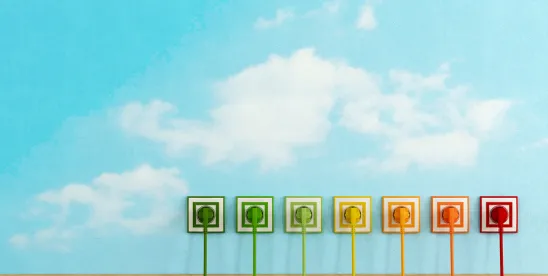On March 11, the New York State Energy Research and Development Authority (“NYSERDA”) filed its proposed Implementation Plan to administer its Energy Storage Market Acceleration Bridge Incentive Program and support the ambitious New York Public Service Commission (“PSC”) order requiring 1.5 GW of energy storage in New York by 2025 and 3 GW by 2030 (the “Storage Order”). The Implementation Plan breaks down the state’s incentive strategy primarily between “Retail Storage Incentives” and “Bulk Storage Incentives,” and provides essential preliminary details for sponsors, investors, and lenders considering energy storage projects in the state. Both programs will officially launch in Q2 2019. This article summarizes the program framework generally but focuses on the key attributes of the Retail Storage Incentives program (the “Retail Program”) and associated NYSERDA Retail Energy Storage Incentive Program Manual (the “Program Manual”). A subsequent article will address the Implementation Plan’s Bulk Storage Incentives and associated program manual.
Retail Program Funding and Scope
The Storage Order authorized a $310 million investment in energy storage deployment to be administered by NYSERDA, in addition to $40 million previously made available solely to energy storage paired with solar projects. The Implementation Plan preliminarily allocates $130 million to Retail Storage Incentives and $150 million to Bulk Storage Incentives. The Implementation Plan notes that an additional $53 million in Regional Greenhouse Gas Initiative (“RGGI”) funds will later be made available for retail and bulk storage projects specifically located on Long Island.
 The Retail Storage Incentive will be a fixed up-front amount per kilowatt-hour (“kWh”) of “usable installed storage capacity” for projects up to five megawatts (“MW”) of alternating current (“AC”) capacity. Projects will receive an initial incentive level of $350 per kWh for the first four hours of a system’s storage duration, after which the rate will be reduced by 50% for hours five and six. No incentive is provided for storage capacity beyond six hours. The incentive is capped at 15 megawatt-hours (“MWh”).
The Retail Storage Incentive will be a fixed up-front amount per kilowatt-hour (“kWh”) of “usable installed storage capacity” for projects up to five megawatts (“MW”) of alternating current (“AC”) capacity. Projects will receive an initial incentive level of $350 per kWh for the first four hours of a system’s storage duration, after which the rate will be reduced by 50% for hours five and six. No incentive is provided for storage capacity beyond six hours. The incentive is capped at 15 megawatt-hours (“MWh”).
A project may be a standalone energy storage system or paired with a solar photovoltaic (“PV”) system, and it may be interconnected behind a customer’s electric meter or directly into the distribution system. The Implementation Plan also requires that a project’s value must be “monetized under an Investor Owned Utility (‘IOU’) tariff in the form of bill savings or credits.”
The Retail Program will administer awards for standalone energy storage systems and completed distributed generation systems being retrofitted to add energy storage. “Distributed generation” includes solar PV, fuel cell, and combined heat and power. Although the incentive will be identical, the NY-Sun Incentive Program will administer awards for new or approved, but not completed, solar PV installations in the NY-Sun Program that are paired with energy storage.
NYSERDA will administer the Retail Program through a first come, first served block application process for a specific target of MWh in each block. $35 million will initially be made available for Block 1 projects to support the deployment of 100 MWh of storage. Thereafter, the $350/kWh incentive level gradually steps down and blocks are bifurcated between New York City projects and projects located elsewhere in the state. A separate block is made available for Long Island. The Program Manual table below summarizes the initial incentive blocks:

NYSERDA reserves the right to adjust the final block incentive levels and block sizes based on “market factors” and as necessary to “optimize the Program’s ability to achieve overall program goals.” Subsequent blocks may be further tailored to specific regions. Each block’s ultimate funding allocation may be further adjusted due to cancellations, project budgetary allocations, or project adjustments after the block is closed. If an awarded project is canceled or terminated, the allocated funds will be made available again to the block under which the canceled project applied. If the original block is closed, the funds will be allocated to a subsequent block. Projects may only receive the incentive rate that exists at the time the project application is submitted.
Incentives will be paid directly to the “Participating Contractor” of record for the project, or to an approved assignee, as discussed below.
Application Tips
Prospective applicants should strongly consider project characteristics emphasized in the Implementation Plan that are likely to be viewed favorably by reviewers. The Implementation Plan is intended to pursue various specific grid benefits: reducing peak demand, increasing grid flexibility and resiliency, and time-shifting cleaner generation to displace higher-emitting generation sources. The Implementation Plan also makes clear that an overarching goal is market acceleration to encourage a flourishing, self-sustaining market that ultimately operates without incentives. Finally, the Implementation Plan reflects an eagerness for the developers to invest in establishing or growing New York business operations, as well as target projects to benefit low-to-moderate income (“LMI”) communities. All prospective projects should be evaluated through the prism of these desired energy, market, and economic outcomes.
System Eligibility and Applicant Requirements
The Implementation Plan anticipates projects will “likely” use energy storage systems to shift a customer’s electric demand to off-peak periods; shift solar PV generation to more valuable times; and charge at off-peak times and discharge during peaks to relieve grid constraints.
Eligible projects will include:
-
Retail, demand-metered customers that install stand-alone energy storage, or storage paired with on-site generation such as solar PV behind the customer’s electric meter (“BTM”);
-
Standalone energy storage or storage paired with an eligible generation source such as solar PV, connected directly into the distribution system and compensated under the Value of Distributed Energy Resources (“VDER”) Value Stack tariff; and
-
Retail, non-demand metered customers that install energy storage paired with a solar PV system BTM.
For customer-sited energy storage systems, the customer must be enrolled in and continue to participate for at least five years in a distribution utility demand response program, a Non-Wires Alternative (“NWA”) contract, a more granular delivery rate, or the VDER Value Stack tariff.
Each project must satisfy the following requirements:
-
The storage system must be electric grid-connected chemical, thermal, or mechanical storage and operated primarily for electric load management or shifting electric generation to more beneficial time periods while operating in parallel with the utility grid. The Program Manual permits energy storage systems to also provide services for back-up power, uninterruptible power supply (UPS), resiliency, or power quality, provided that such services are “secondary.”
-
The project must be a “new, permanent, and stationary system.” The system may not be relocated without NYSERDA’s written approval and must remain in the state of New York for its entire life. NYSERDA’s approval and geographic limitations may cause concerns for investors in sale leaseback transactions and lenders who will resist constraints on foreclosure rights in the event of a sponsor default.
-
Projects must be solely comprised of commercial equipment. “Experimental, beta, or prototype equipment” is expressly excluded.
-
The system must be designed for a minimum 80% round-trip efficiency.
-
The system must be installed in accordance with the design and system components submitted in the project application and approved by NYSERDA. Unapproved deviations from the application design could subject the applicant to forfeiture of the incentive.
-
Equipment must have a minimum ten-year manufacturer’s warranty. The Implementation Plan requires that the warranty cover “the entire energy storage system, including ancillary equipment, pumps, thermal management and power electronics.” It is not clear how the administrators of the program would scrutinize the warranty coverage for a PV+storage project application with shared components, such as an inverter utilized by the PV panels and battery that only has a five-year manufacturer’s warranty.
-
Equipment must have received UL certifications as outlined in Section IX of the Program Manual by the time the system begins commercial operation.
-
The system must be installed in compliance with all manufacturers’ installation requirements, applicable laws, regulations, codes, licensing, and permit requirements. New York has struggled with permitting bottlenecks in recent years. New York City issued a permitting guide for outdoor energy storage installations last year, but guidance for interior systems is still in development. Applicants should ensure they are comfortable with a system’s permitting challenges, especially if located in dense, urban areas.
-
The end customer must be a contributor to the System Benefits Charge.
-
The system must be designed and installed by a “Participating Contractor,” which is discussed below.
NYSERDA will maintain a public listing of approved “Eligible Contractors” that may act as a Participating Contractor who will contract directly with the end customer. The Implementation Plan permits the assistance of subcontractors, but it makes clear that the Eligible/Participating Contractor will remain responsible for all aspects of the project, including installation, maintenance, operation, and NYSERDA compliance.
Contractors will be required to apply for NYSERDA approval based on criteria detailed in the Program Manual. Contractors must provide information on relevant project experience, three customer references, and performance in other New York utility programs.
NYSERDA reserves the right to deny applications where contractors are delinquent on any other NYSERDA-funded projects.
The Implementation Plan permits a Participating Contractor to assign the incentive payment to a third party approved by NYSERDA. It is common for state-level grant programs to permit applicants to assign incentive payments to suppliers, installers, or developers who provide equipment and/or services to the project. Importantly, the Participating Contractor must identify the payee at the time of project application submission. This may be difficult for developers who would otherwise require additional time to finalize financing parties. Furthermore, the Program Manual requires that the Participating Contractor, customer, and payee must sign the project application agreeing to the payee assignment. Assignee requirements may pose challenges for developers that would otherwise consider assigning the incentive to a lender or investor as part of an overall financing transaction. Applicants should be clear with NYSERDA regarding the financing structures that will be used for the given project and prepare staff for the timeframe and nature of potential financing party requests for consents, estoppels, or other program documentation.
A Participating Contractor may assign an awarded project to another Participating Contractor, provided the request is submitted prior to requesting incentive payment.
Application Submissions
Once fully launched, the NYSERDA website will contain a portal for online applications. Application submissions must include the following information, among other materials identified in the Program Manual:
-
System location;
-
The type of facility where the system will be installed;
-
Customer information (for BTM projects);
-
Summary of the intended use of the system;
-
Summary of the intended design of the system;
-
Description of the system, including technology type, manufacturer, kW and kWh, and roundtrip efficiency;
-
Proof of any UL safety listings currently obtained;
-
Proof of warranties; and
-
Eligible Contractor and customer certifications.
A customer agreement must be on file with the Participating Contractor and available upon NYSERDA request.
A project submitted to a utility interconnection queue before March 11, 2019, will not be eligible for the Retail Incentive. It is not clear how application reviewers would scrutinize a planned PV project removed from an interconnection queue that later adds an energy storage component and re-applies for interconnection. Projects previously selected, submitted, or in negotiation before March 11, 2019, under an investor-owned utility Non-Wires Alternative, are also not eligible.
Projects receiving the Retail Incentive are prohibited from receiving the Bulk Storage Incentive or a NYSERDA Renewable Energy Credit under Renewable Energy Standard procurements.
Inspection and Ongoing Compliance
The Program Manual sets forth specific project development milestones that must be achieved for awardees to continue reserving their incentives. Project updates must be filed every 90 days.
A program awardee must pass NYSERDA system inspections during construction and after the completed system receives a utility’s permission to operate. Inspections will not be required after the Participating Contract receives successful inspections for at least three other similarly-sized projects “without critical or major deficiencies.” Until a Participating Contractor has successfully installed three projects, all awarded projects will be subject to an initial 90 days of monitoring and verification.
No incentive will be paid to the Participating Contractor until NYSERDA receives and approves the following, and as more fully detailed in the Program Manual:
-
Siting and permitting approvals;
-
Utility permission to operate;
-
Final Professional Engineer-stamped system designs;
-
Total installed project cost;
-
A decommissioning plan; and
-
Completion of NYSERDA’s quality assurance inspection and resolution of any issues identified.
Program awardees must install a revenue grade meter to record system charge and discharge activity. Notably, a Participating Contractor is responsible for retaining interval data for the first five years of operation for NYSERDA measurement and verification. The Program Manual requires 15-minute data for demand charge use cases and hourly interval data for VDER Value Stack tariff compensation installations. Applicants constructing PV+storage projects who also plan to claim the federal investment tax credit (“ITC”) on integrated storage components should consider how best to incorporate various metering obligations and ensure consistent reporting.





 />i
/>i

